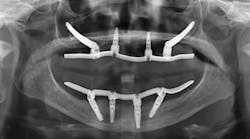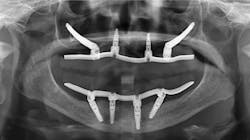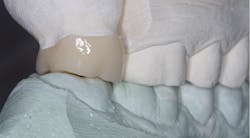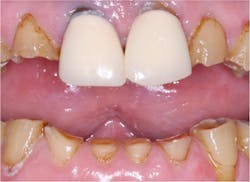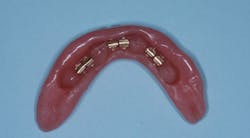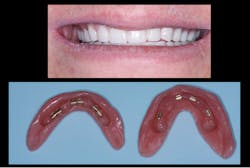Q: I am a mature dentist who has practiced from the gold alloy and porcelain jacket crown period to the porcelain-fused-to-metal era, and now for 10 years in the zirconia and lithium disilicate time. I am seeing varied occlusal challenges related to some of the crowns. Nobody seems concerned about the occlusal challenges present with the ceramic crowns.
More by the author:
A: I spend much of my time speaking to dentists globally, visiting dental offices, teaching in study clubs, doing research, and practicing dentistry. I hear about clinical occlusion challenges from the dentists and staff persons in these many groups. In my opinion, your question is one of the most significant problems in clinical dentistry today. Occlusion is taught only minimally in almost all dental schools in the US, and that problem certainly shows in the dental restorations I see in patients.
Zirconia crowns in dentistry: Uses, clinical challenges, and solutions
Before discussing some of the occlusal challenges, what are the characteristics of normal occlusion? What are we attempting to reproduce with a typical crown or fixed prosthesis for the majority of patients? The characteristics and terminology of normal occlusion are redefined by authors periodically, adding to the confusion.
The following summarizes the current research in the literature combined with my personal experiences concerning the most commonly occurring characteristics for normal occlusion. I assume the occlusal words and definitions are known by readers, and I am sure some will disagree with at least a few of my statements:
- Curve of Spee forms a slight arch in the occlusion from anterior to posterior (figure 1A).
- Curve of Wilson forms a slight arch in the occlusion from left to right (figure 1B).
- In maximum interdigitation (MI), there is at least one centric stop on each tooth.
- Incisal guidance is almost always present.
- Incisal guidance discludes all posterior teeth.
- There is a slight forward slide of about 1 mm from centric relation (CR) to MI.
- The CR to MI slide is nearly always forward without lateral deviation.
- Canine rise is present about 75% of the time. The remainder of patients have a group function of the posterior teeth when the mandible is moved laterally or forward.
- Canine rise discludes all posterior teeth.
- Nonworking contacts are not present when the mandible is moved laterally.
- About 75% of patients do not have grinding or clenching bruxism habits.
The Clinicians Report Foundation TRAC division (Technologies in Restoratives and Caries Research) has ongoing in vivo research on thousands of crowns. The most common factor for crown success or failure has been identified to be inadequate implementation of correct occlusion concepts, either by laboratories or clinicians or both. Here are some of the occlusal challenges we see from this research.
Crowns or fixed prostheses purposely constructed out of occlusion by a laboratory, which causes extrusion of the opposing arch of teeth over weeks and up to many months. This is a common problem related to technicians wanting the dentist to have the patient say “that feels great” while not knowing the restoration(s) do not touch occlusally, or they do not want the clinician to adjust the restoration. The result of this situation is an unavoidable change in occlusion over many months, potentially causing fracture of adjacent overloaded teeth that are still in occlusion as well as significant changes in overall occlusal contacts (figure 2).
Crowns or fixed prostheses purposely constructed out of occlusion opposing an immovable fixed prosthesis, disallowing much of the potential extrusion and severely changing occlusion over a period of months or longer.
Single crowns with open contact areas often caused by leaving the contact light start creating food impaction, caries, and periodontal disease.
Placing an implant-supported crown adjacent to a natural tooth without ensuring that the occlusion on the natural tooth is interdigitated with the opposing tooth, thus locking it in place. This situation often creates opening of the mesial contact between the implant and the natural tooth in a few months due to mesial drift of the tooth adjacent to the implant, with the result of occlusal changes. Such situations might be better served with a fixed prosthesis, not an implant.
Placing ceramic crowns of unknown zirconia composition or with veneering ceramic on crowns that wears opposing teeth, thus inviting inevitable natural tooth wear and occlusal shifting (figure 3).
The original Glidewell Laboratories unglazed BruxZir does not wear opposing teeth in TRAC studies, but new varieties of zirconia formulations or layered zirconia are wearing natural teeth.
Placing crown with canine rise in patients who previously had worn or naturally occurring group function and no canine rise. This causes undue force on the canine and the opposing teeth, potential ceramic fracture, or movement of the canine facially and open restoration contact areas.
Placing a canine crown without canine rise in situations where there was a previous canine rise causing working and nonworking prematurities on potentially both sides of the mouth.
Placing zirconia or lithium disilicate restorations on opposite arches without knowledge of the wear potential of the almost always present veneering material, thick or thin, placed to enhance the color of the restorations.
Neglecting to provide an occlusal splint for patients with many ceramic crowns. Splints avoid opposing arch dentition wear and the development of occlusal prematurities.
This next situation is a very common one when observing the current trend to oppose zirconia restorations on two edentulous arches without meticulous and knowledgeable occlusal equilibration. This can cause an implant or two to take the entire occlusal load, causing undue forces and stress on theAfter many decades of prosthodontic practice and hundreds of rehabs, I have found this an almost impossible and threatening technique. There is no articulator that can consistently mimic patient occlusion. Definitive occlusal equilibration is mandatory at seating, after a few weeks in the mouth, and subsequently on recare appointments (figures 4–6).
There is no question that the knowledge level regarding occlusion in both the laboratory profession and the dental profession—and implementation of that knowledge—could be much better.
How can the described occlusion challenges and many other occlusion maladies be prevented or improved? Both dental laboratory technicians and dentists must be involved with reducing or eliminating them. I suggest the following solutions:
- Consider your knowledge of occlusion. If you perceive the need to upgrade it, please attend pragmatic occlusion courses and implement the information into your practice. Unfortunately, some occlusion courses available are unrealistic and not pragmatic. I will identify our PCC course for you later in this article. It deals directly with the day-to-day occlusion problems that dentists encounter routinely and how to overcome them.
- Take your technician(s) to lunch or dinner and have an in-depth discussion about the occlusal challenges you face. Undoubtedly, you have similar problems to the ones I have identified in this article and others.
- Decide with your technician(s) how you can overcome the commonly occurring occlusion challenges.
- Continue to communicate with your laboratory until you have overcome the problems.
Summary
Occlusion is one of the three main conditions we treat—caries, periodontal disease, occlusion. However, it does not receive the educational emphasis it needs to satisfy the many occlusal challenges present in the profession. If you feel you need more knowledge in occlusion, find courses that meet your needs and continue to expand your knowledge. You and your patients will benefit significantly.
Author’s note: The following educational materials from Practical Clinical Courses offer further resources on this topic for you and your staff.
One-hour videos:
- Bruxism—Prevention and Treatment (Item# V3162)
- Simple TMD Therapy for Your Practice (Item# V3106)
- Uncomplicated Occlusal Equilibration (Item# V3105)
- Opening Vertical Dimension of Occlusion (and Other Adjunctive Occlusal Procedures) (Item# V3186)
Two-day hands-on course in Utah:
- Restorative/Implant Dentistry 3 with Dr. Gordon Christensen
For more information, visit our website at pccdental.com or contact Practical Clinical Courses at (800) 223-6569.
Editor's note: This article appeared in the March 2022 print edition of Dental Economics. Dentists in North America are eligible for a complimentary print subscription. Sign up here.
